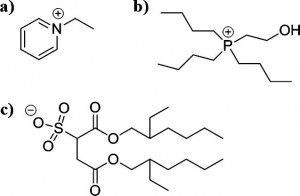
Chemical structures of the IL precursors used in this study: (a) 1-ethylpyridinium, (b) tributyl(2-hydroxyethyl)phosphonium and (c) bis(2-ethylhexyl)sulfosuccinate (docusate)
In this study Tony McNally and co-workers in Northern Ireland, Spain and the USA show that dual functional ionic liquids can uniquely provide both a plasticising effect for medical polymers, and exhibit antimicrobial and antibiofilm-forming activity to a range of antibiotic resistant bacteria.
Poly(vinyl chloride) (PVC) is widely used in the manufacture of a range of medical devices, including endotracheal tubes and catheters. The unique flexibility of PVC for use in such applications is derived from the use of phthalate esters as plasticisers. However, the possible carcinogenic and reprotoxic effects of phthalates has been a concern for some decades since their identification as an environmental contaminant. Another problem with medical devices is the risk of infection of indwelling medical devices as bacteria can colonise and form a biofilm on the surface. As device-related infections are recalcitrant to conventional antimicrobial therapy and host defences, alternative agents for their treatment are required. Ionic liquids have been shown in separate experiments to have antimicrobial activity and a plasticising effect on polymeric materials.
This study reports the design of two dual functional ionic liquids which uniquely provide a plasticising effect, and exhibit antimicrobial and antibiofilm-forming activity to a range of antibiotic resistant bacteria. The design approach adopted will be useful in developing ionic liquids as multi-functional additives for polymers.
Interested in knowing more? Read the full article here. Free until June 3rd.
Dual functional ionic liquids as plasticisers and antimicrobial agents for medical polymers
Seong Ying Choi, Héctor Rodríguez, Arsalan Mirjafari, Deirdre F. Gilpin, Stephanie McGrath, Karl R. Malcolm, Michael M. Tunney, Robin D. Rogers and Tony McNally
Green Chem., 2011, Advance Article
DOI: 10.1039/C1GC15132K










